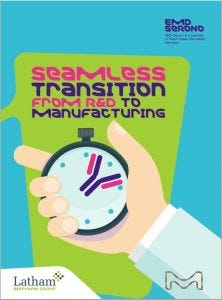- Sponsored Content
- Economics
- Contract Services
- Regulatory Affairs
Seamless Transition from R&D to ManufacturingSeamless Transition from R&D to Manufacturing
Sponsored Content
 Fast and cheap: These criteria are becoming ever more urgent drivers for manufacturers of biologics, faced with increased scrutiny on the costs of developing novel drugs, the lengthy timelines for delivering these drugs to patients, and the tightening competition to capitalize on new targets. The challenge for manufacturers is further heightened by the expectations to deliver on quality as well.
Fast and cheap: These criteria are becoming ever more urgent drivers for manufacturers of biologics, faced with increased scrutiny on the costs of developing novel drugs, the lengthy timelines for delivering these drugs to patients, and the tightening competition to capitalize on new targets. The challenge for manufacturers is further heightened by the expectations to deliver on quality as well.
Although development and production of molecules such as monoclonal antibodies (MAbs) have greatly benefited from the “platformization” of core technologies and processes, the transition from research and development (R&D) to a manufacturing organization (internal or external) often is uneven at best, resulting in delays to overall timelines. That such delays often occur may seem curious at first glance, because even early phases of discovery research require production of pure molecules to support cellular and in vivo efficacy models. Manufacturing platforms increasingly find their way into R&D organizations to facilitate eventual transfer to the next production group. However, such transfers may suffer from an imperfect fit of the platform processes practiced in the respective organizations, or worse, from a misalignment of strategic goals of the R&D and manufacturing functions within one organization. Lack of communication between the two functions of one organization creates an even more difficult environment for facilitating transfers, both in the short term (projects) and long term (technology development and implementation).
For many R&D organizations, a critical path activity for filing an investigational new drug application (IND) includes the pivotal GLPtoxicology study to ensure that a proposed new drug candidate has an acceptable safety profile at the dosages anticipated for human trials. As IND filing deadlines approach, other activities often appear on the critical path – for NBEs (novel biological entities), those may include creation of the production cell line (and master cell bank) and development of formulation and analytical methods for specification and release. Upstream and downstream processes, even if they are platform, must be verified and locked before production of the first GMP batch. The quality function must ensure that such activities are appropriate and conform to the highest acceptable standards, both internally and in compliance with regulatory expectations. What is often unclear, or even unaddressed, is where these functional responsibilities reside and how best to use the strengths of participating organizations within the company. Often missing as well is a central, overarching strategy to move promising candidates through the pipeline efficiently from research into development, including a clear understanding of decision-makers and decision stage-gates as the product candidate progresses.
Just fill out this form to download the eBook of this special report.
You May Also Like






